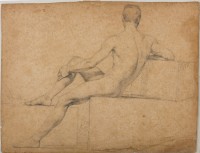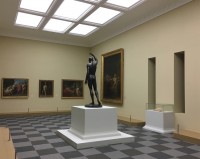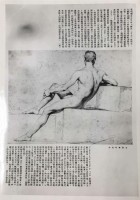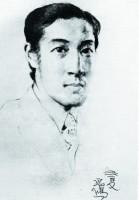The browser will either open the file, download it, or display a dialog.

During the winter of 2019–20, the Shanghai Museum hosted a major loan exhibition of late eighteenth-century and early nineteenth-century French academic art called La Naissance des Beaux-Arts (The Birth of the Fine Arts).[1] To the eighty-five works borrowed from France, the Shanghai Museum was able to add a single work from its own collection: an academic drawing of a seated male nude, probably dating from the early years of the nineteenth century (fig. 1). The drawing, long attributed to Jean-Auguste-Dominique Ingres, has been in the possession of the museum since 1977, but it had never been shown by the institution before.[2] For the duration of the exhibition, it was reunited with works by Ingres’s teacher, Jacques-Louis David (1748–1825), as well as other French artists from the reign of Louis XIV to the imperial regime of Napoleon, roughly from 1650 to 1815.
Displayed in a vitrine in the central room of the exhibition, the drawing of a young male model artfully posed on a series of wooden boxes formed an interesting counterpoint to the large Ecorché with Raised Arm of 1790 by Jean-Antoine Houdon, which, standing in the center of the room, commanded the exhibition (fig. 2).[3] The reason for the drawing’s presence in the exhibition and its significance may not have been immediately understood by all. Indeed, the Shanghai drawing attributed to Ingres added little to the exhibition’s theme or to the knowledge of the draftsmanship of an artist by whom several thousands of undisputed drawings are known.[4] However, this drawing played an important role in twentieth-century Chinese cultural history. It is the only French academic drawing in a museum collection in China, a destination it reached via a curious itinerary that was prompted by one of the first and best-known Chinese artists to have studied in France, the painter Xu Beihong (徐悲鸿; 1895–1953). After its arrival in Shanghai, the drawing was owned for many years by one of the most fascinating literary figures in 1930s China, Shao Xunmei (邵洵美; 1906–68), and his wife, the equally interesting Sheng Peiyu (盛佩玉; 1905–89), before it disappeared during the Cultural Revolution (1966–76). It eventually resurfaced and ended up in the Shanghai Museum. This article, then, is focused less on the drawing itself or even on the conundrum of its attribution to Ingres than on its cultural significance in early modern China.
Between the Seine and the Huangpu River
During his study period in France from 1919 to 1927, the early twentieth-century artist Xu Beihong (then known in France as Ju Péon) spotted a drawing, attributed to Ingres, in the shop of an antique dealer on the rue de Seine, a stone’s throw away from the École des Beaux-Arts where he had studied from 1921 to the end of 1924.[5] Not able to acquire it himself, he convinced one of his friends, Shen Xu’an, (沈旭庵) to buy it. Little is known about Shen, except that he was well off and interested in the arts, including not only the fine arts but also music.[6] One of the reasons Xu was unable to buy the drawing himself was that he was in the process, around the same time, of buying an oil painting by and from his mentor, Pascal Dagnan-Bouveret (1852–1929). The painting in question, Ophelia, is preserved today in the Xu Beihong Memorial Museum in Beijing.[7] Both acquisitions were part of Xu’s effort to bring to China original works by European masters, in addition to copies made in museums.[8]
Xu Beihong on Ingres
In 1931, Xu published the drawing bought by his friend in Paris in an article in the cultural magazine Shidai Huabao (时代画报; Modern Miscellany; fig. 3),[9] using it at once as an opportunity to introduce a work of a major French master to the Chinese public and as a pretext to voice his opinion in a debate among modern Chinese artists as to what Western examples to follow. Xu condemned those artists who looked at contemporary Western art, in particular the works of the painters of the school of Paris, without knowing about the European artistic tradition and its Greco-Roman roots (his main target was Liu Haisu [刘海粟; 1896–1994]).[10] By contrast, he advocated for a modern art that was securely rooted in that tradition, achievable only through solid academic training. Ingres was Xu’s chief model. Measuring him against Eugène Delacroix, Xu preferred Ingres, even though he saw limitations in the latter’s paintings, particularly when it came to color. Comparing Delacroix with Richard Wagner and Ingres with Ludwig van Beethoven, he recognized Delacroix’s energy and talent but ultimately found that he could not reach Ingres’s level. And, wrote Xu, he felt he was in good company. No less than the impressionist painter Edgar Degas had also looked upon Ingres as the supreme teacher.
“Le Dessin est la probité de l’art” (Drawing is the probity of art). In his article, Xu cites (in French!) Ingres’s famous phrase inscribed on the Ingres monument that stood in the vestibule of the Quai Malaquais entrance to the École des Beaux-Arts.[11] At a time when China was, according to Xu, in a period of decay, it needed Ingres, who strove for honesty and integrity in art.
The Ingres Drawing’s Fate in Shanghai
What happened to the drawing after it was bought by Shen is unclear. Until recently, it was generally accepted that Shen brought it to China and then sold it at some unknown time and place. The drawing eventually ended up in New York, where it was bought by the well-known author and publisher Shao Xunmei.[12] Traveling to New York in the 1940s on behalf of the Chinese film industry,[13] Shao recognized the drawing in a dealer’s gallery as the one he had seen in Shanghai in 1931, at the time of its publication in Shidai Huabao, a magazine in which he had heavily invested in 1930. He immediately bought the drawing—already famous in China through Xu’s article—and brought it back with him to Shanghai.[14] At the onset of the Cultural Revolution in 1966, he turned to the Shanghai section of the People’s Literature Publishing House (人民文学出版社上海分社; Renmin Wenxue Chubanshe Shanghai Fenshe), where he was employed, to safekeep the work, which was one of the jewels of his personal collection.[15]
As recently as December 2019—no doubt inspired by the exhibition of the Ingres drawing in the Shanghai Museum—author and journalist Lou Chengzhen (楼乘震) published an alternative version of the provenance of the Ingres drawing based on new research, particularly in the memoirs of Shao’s wife and daughter.[16] Lou claims that Shao did not buy the drawing from a dealer in New York in the 1940s but rather from Shen Xu’an in Paris in the mid-1920s, when he lived in the city at the same time as Shen and Xu. Xu’s role in this transaction is unknown. That he and Shao had more than a superficial relationship in Paris, however, is borne out by a portrait drawing of Shao by Xu (fig. 4), dated 1925. The two men continued their friendship and collaboration in China in the early 1930s. Xu provided drawings and articles for magazines in which Shao had a hand, such as Shidai Huabao and Jinwu Yuekan (金屋月刊; Gold Chamber Monthly).
According to the memoirs of his wife, Sheng Peiyu, published in 2004, Shao came back to Shanghai in 1926 with nothing but two boxes of foreign-language books and the Ingres drawing.[17] In 1927, when he married Sheng, he gave her the drawing as a wedding present.[18] According to Sheng, it always hung in their home. In 1937, during the Japanese invasion of Shanghai, Shao and his family took refuge with friends in the French Concession. His American mistress, the legendary author Emily (“Mickey”) Hahn,[19] noticed that his house was robbed by the Japanese, who confiscated most of the artworks in Shao’s collection but left the Ingres drawing hanging on the wall. As Hahn knew the drawing was meaningful to Shao and his wife, she took it off the wall and returned it to them.
In 1946, Shao was sent by the Chinese government to buy film equipment in the United States. Apparently in doubtful financial straits, he took the Ingres drawing with him in the hope of monetizing it. He showed it to a dealer near the corner of Fifth Avenue and East Fifty-Seventh Street, who valued it at $8,000 but offered to buy it for $5,000.[20] Shao was unwilling to sell it at that price and took the drawing back to Shanghai.
By the 1950s, Shao was completely out of the publishing business and made a living as a translator and by selling whatever valuables he had left after the Japanese raid of his business and his home. But, though he may have pawned it at some point, he never sold the Ingres drawing. According to his daughter Shao Xiaohong (邵绡红), he said that he could never part with the Ingres drawing. “I could never part with the Ingres drawing; another reason is that it was created by a famous painter so it’s difficult to evaluate its price. Even when Shen Liang [Shen Xu’an] sold it to me it was worth 1,000 (silver) yuan. Of course, I don’t care how much I can get for it. I feel [bad] that I’ve been selling my favorite things one by one, it seems as if I am failing my good friends one by one!”[21]
In 1966—the point at which the traditional and revised stories of the drawing converge—Shao was afraid to keep the drawing in his house. He packed it up with other valuables and shipped it to the People’s Literary Publishing House for safekeeping. The drawing was accompanied by a note in Shao’s handwriting stating, “This drawing is a genuine work by Ingres, a French 16th [sic]-19th–century painter. A signature in pencil is on the back. Keep it clean.”[22] The drawing was accidentally rediscovered (by some accounts, in the trash) and submitted to the Shanghai Municipal Administration of Cultural Heritage,[23] which offered it to the Shanghai Museum. Before integrating the drawing into its collections, in 1977, the museum consulted with Chinese artists who, like Xu, had studied at the Ecole des Beaux-Arts in Paris. These included the eighty-four-year-old Yan Wenliang(颜文樑); 1893–1988,[24] who by then had survived Xu for twenty-four years. The drawing is currently ranked as yijiwenwu (一级文物; first class cultural relic).[25]
The Drawing
The Shanghai drawing shows a young male nude model with short hair, turned away from the viewer. He is seated on a wooden box, leaning backward with his right arm on a second, higher box. His left leg is placed on the floor and the right, steadied by his left arm, is bent and rests on a third, lower box. While we are presented with a rear view of the head and shoulders, the lower part of the body is seen in profile. This causes the back to be twisted along a serpentine curve. The drawing measures 274 x 350 mm (10.75 x 13.75 in) and is executed in graphite pencil on cream wove paper. It is inscribed on the image side with the words “à Rom[e?]” (in Rome), and on the reverse with the words, “Ingres à Rome.” Neither inscription appears to be in Ingres’s handwriting, although the one on the front (four letters) is too short to make a definitive judgment.
The drawing is a typical académie (a drawing made from a live model, usually in the academy) and, if indeed it was executed by Ingres in Rome, it must date from the time when he was a boarder in the Villa Medici (1806–10) or, less likely, the subsequent years he spent in Rome (1810–20). It is noteworthy that, by the time he arrived in Rome, Ingres was already an accomplished artist, several of whose works had been accepted to the Paris Salon, so the practice of académies was a little behind him.
Several Ingres experts have looked at the drawing, both in real life and in reproduction, but there is no unanimity of opinion. Some are convinced that the drawing is by Ingres, others would prefer the designation “circle of Ingres.” Without a firm provenance prior to the appearance of the drawing in a dealer’s shop in Paris in the mid-1920s, it will probably never be possible to securely attribute the drawing to Ingres. What is important, however, was that Xu and his contemporaries firmly believed the drawing to be by Ingres and saw it as an exemplary work, from which Chinese artists could learn the core principles of art.
Philippe Cinquini
Researcher, Xu Beihong Art Institute, Renmin University of China
philippe[at]cultureartcinquini.com
Translated and edited by Petra Chu and Liu Jing.
[1] The exhibition La Naissance des Beaux-Arts, du Grand Siècle à la Révolution (美术的诞生:从太阳王到拿破仑), featuring works from the collections of the Beaux-Arts de Paris (the new official name of the École Nationale Supérieure des Beaux-Arts) and the Musée du Louvre in Paris, was curated by Philippe Cinquini and Alice Thomine-Berrada and took place in the Shanghai Museum from November 5, 2019 to February 9, 2020.
[2] The Shanghai Museum was founded in late 1952. It moved to its current, purposely designed building in 1996.
[3] The large Écorché au bras levé in the collection of the Beaux-Arts de Paris measures 75 ½ x 27 ½ x 31 ½ in. (192 x 70 x 80 cm).
[4] The Musée Ingres Bourdelle, located in Ingres’s birthplace Montauban (France), alone owns more than 4,500 drawings by the artist.
[5] Xu Beihong departed for France in March 1919 and arrived on May 10 of the same year. During the summer of 1920, he studied for three months at the Académie Julian before enrolling, in October, at the École des Beaux-Arts, joining the Atelier Flameng. In the summer of 1921, he left for Berlin, where he stayed until the spring of 1923, making several round trips to Paris. Back at the École des Beaux-Arts in March 1923, he studied with Lucien Simon (1861–1945) until November 1924, when he reached the age limit (thirty) for the École des Beaux-Arts. He then studied at the private academy La Grande Chaumière, named after the street in Montparnasse in which it was located. In late September, he traveled back to China via Singapore, arriving in February 1926. He returned to Paris in summer 1926 and re-enrolled at La Grande Chaumière, in addition to traveling to Belgium, Switzerland, and Italy. Upon his permanent return to China, he developed new ways of painting in oils and ink that put him on a collision course with the modernist tendencies of Lin Fengmian (林风眠; 1900–1991) and Liu Haisu (刘海粟; 1896–1994). After the founding of the People’s Republic of China in 1949, Xu became president of the Central Academy of Fine Arts in Beijing. Today, he is well known in the West for his ink paintings of running horses, and in China for his large-scale oil paintings on Chinese historical or mythological themes. The Xu Beihong Memorial Museum in Beijing is devoted to his art.
[6] Apparently, Shen came from a well-to-do family in the Jiangnan region. He spent some time in Paris, where he befriended Xu. The latter refers to him as the buyer of the Ingres drawing in his article on the drawing published in Shidai Huabao 时代画报, 1931, 17. He calls Shen his “friend,” and mentions his love of music, especially Beethoven, whom Xu compares with Ingres.
[7] From 1920 to 1927, Xu Beihong frequently visited the academic naturalist painter Pascal Dagnan-Bouveret in his atelier in Neuilly, a suburb of Paris. Xu considered Dagnan-Bouveret his maître (teacher), even though the artist, himself a former student of the École des Beaux-Arts, never taught at the school.
[8] The Xu Beihong Memorial Museum in Beijing owns several copies in oils and pastels after Western artists ranging from Jacob Jordaens (1593–1678) to Pierre-Paul Prud’hon (1758–1823) and Aimé Morot (1850–1913).
[9] Shidai Huabao, 17.
[10] Together with Yan Wenliang (颜文樑; 1893–1988) and Lin Fengmian (林风眠; 1900–1991), Liu and Xu were, what are called in China, the “four great academy presidents.” Pioneers of Chinese modern art, these four men exerted much influence as the presidents of China’s most important art academies in Soochow, Hangzhou, Shanghai, and Beijing, respectively.
[11] The phrase is inscribed on a piece of paper held by Ingres in his half-length portrait bust by Eugène Guillaume (1822–1905) at the center of the monument. See “Monument d’Ingres à l’Ecole des Beaux Arts, quai Malaquais, 6ème arrondissement, Paris,” Paris Museum Collections, accessed February 5, 2019, http://parismuseescollections.paris.fr/.
[12] Born in Shanghai, Shao was a poet, translator, journalist, and publisher, well known in Chinese intellectual and cultural circles between 1926 and 1936. Coming from a large family in Zhejiang, he left for Europe in 1924, already a Westernized literary dandy. In 1925, after roaming around Italy, he enrolled at Cambridge University, where he discovered European literature, notably the works of Algernon Charles Swinburne, Paul Verlaine, and Charles Baudelaire. From Cambridge, he traveled to Paris (still in 1925), where he joined the Tian Gou Hui (Celestial Dog), a small group of young artists and intellectuals inspired by the British and French decadent movements. Celestial Dog was a parody of the very serious association Tian Ma Hui (Celestial Horse), founded in Shanghai in 1919 on a modernist Japanese model. He returned to China in 1926 and published his first collection, Tiantangyuwuyue (天堂与五月; Heaven and May) in 1927. Dedicated to the Greek poetess Sappho and quite erotic, the book caused a scandal and propelled him to the center of the literary world. On Shao Xunmei, see, among others, Jonathan Hutt, “Monstre Sacré: The Decadent World of Sinmay Zau 邵洵美,” China Heritage Quarterly 22 (June 2010), http://www.chinaheritagequarterly.org/. On Shao’s milieu, see also Paul Bevan, A Modern Miscellany: Shanghai Cartoon Artists, Shao Xunmei’s Circle, and the Travels of Jack Chen, 1926–1938 (Leiden, Netherlands: Brill, 2015); as well as the biography of Shao’s mistress in Shanghai, the American writer Emily Hahn, Ken Cuthbertson, Nobody Said Not to Go: The Life, Loves, and Adventures of Emily Hahn (Boston: Faber and Faber, 1998), chs. 4 and 5 (Shao is referred to in the book as Sinmei Zao). As for the frequently alleged presence of Shao at the École des Beaux-Arts, this is not borne out by the school’s archives. See Philippe Cinquini, “Les artistes chinois à l’École des beaux-arts de Paris,” Revue histoire de l’art, 82 (January 2019), http://blog.apahau.org/.
[13] Directed by Chen Guofu (陈果夫; 1892–1951), a Kuomintang leader, Shao accompanied Yan Heming (颜鹤鸣; 1909–2003) to acquire in the United States the equipment necessary to open a film studio in China.
[14] This version of the story is told by the Shanghai Museum in its press releases and may be found online at “现场|巴黎高美珍藏展上博启幕,普桑、大卫、安格尔都来了,” The Paper, November 4, 2019, https://www.thepaper.cn.
[15] An autograph letter preserved in the Shanghai Museum testifies to this event, which took place under dramatic circumstances. See Li Junjie (李俊杰), “Shao Xunmei yu Anggeer sumiao” 邵洵美与盎格尔素描 [Shao Xunmei and the Ingres Drawing], Shanghai Wenbo Luncong上海文博论丛, 3 (2009): 91.
[16] Lou Chengzhen (楼乘震), “Shao Xunmei he yifu sumiao” 邵洵美和一幅素描 [Shao Xunmei and a Drawing], Wenhui Dushu Zhoubao 文汇读书周报, December 16, 2019, 4.
[17] Sheng Peiyu 盛佩玉, Shengshi jiazu, Shao Xunmei yu wo: Sheng Peiyu de huiyi 盛氏家族・邵洵美与我:盛佩玉的回忆 [Sheng Family, Shao Xunmei and me: memory of Sheng Peiyu] (Beijing: Renmin Wenxue Chubanshe 人民文学出版社, 2004), 72.
[18] The wedding took place on January 15, 1927. A wedding album with drawings and calligraphy of Shao’s major artist friends, mostly dating from January 1927, was auctioned at Bonhams, New York, on September 15, 2014. See https://www.bonhams.com/.
[19] On Hahn, see among others Cuthbertson, Nobody Said Not to Go. On her time in China, Emily Hahn, China to Me: A Partial Autobiography (Philadelphia: Blakiston, 1944).
[20] The gallery may have been Knoedler’s, which between 1925 and 1970 was located at 14 East Fifty-Seventh Street.
[21] Shao Xiaohong (邵绡红), Wo de Baba Shao Xunmei 我的爸爸邵洵美 [My Father Shao Xunmei] (Shanghai: Shanghai Shudian Chubanshe上海书店出版社, 2005), 331.
[22] 按此画乃法国16-19世纪画家盎格尔 INGRES(签名在画背,系铅笔字,千万请勿损污秽!)an cihua nai faguo 16 [sic]–19 shiji huajia anggeer INGRES (qianming zai huabei, xi qianbizi, qianwan qing wu sun wuhui!).
[23] The office’s name and the number 1409 are inscribed on the back of the drawing.
[24] See note 10.
[25] The drawing has the museum inventory number 44005.






